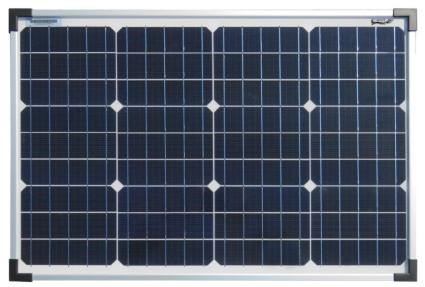Following frequent questions of our customers, in this article we want to explain essential features of solar panels connected to LED lamps. Solar panesl are usuaylly comprised of photovoltaic (PV) cells. These cells are designed to convert sunlight into electrical energy through the photovoltaic effect. When sunlight strikes the surface of the solar panel, it excites electrons within the semiconductor material, generating a flow of electricity.
On the market there are two major types of panels available, monochrystaline and polychrystaline panels. Monochtristaline panels are made from single chrystaline structure generate more power in a smaller amount of space compared to other types of solar panels. They tend to have a uniform black color and a sleek appearance. While they are generally more expensive than other types of panels, their efficiency and longevity often make them a preferred choice, especially in installations where space is limited.

Widely availabe on the market are also polychristaline panels. Polycrystalline solar panels are made from silicon crystals that are melted together to form a panel. They have a characteristic blue speckled appearance due to the multiple crystals within the panel. Polycrystalline panels are typically less expensive to produce than monocrystalline panels, making them a cost-effective option for many applications. However, they are slightly less efficient and space-efficient than monocrystalline panels, meaning they require more space to generate the same amount of power. Polycrystalline panels are commonly used in large-scale solar installations where space is less of a concern, e.g. in solar farms.
The efficiency of a solar panel depends on various factors such as the quality of the PV cells, the angle and orientation of the panel towards the sun, and environmental conditions like shading and temperature. Modern advancements in solar panel technology have significantly enhanced their efficiency and durability, allowing for greater energy capture even in less than ideal conditions.
Clear, sunny days with minimal cloud cover are ideal for maximizing solar panel output.Solar panels are most effective when they are tilted at an angle and oriented towards the sun. In the northern hemisphere, solar panels are typically tilted towards the south to capture the maximum amount of sunlight throughout the day. The optimal tilt angle varies depending on factors such as latitude and the time of year, but it is generally close to the latitude of the installation site.The surplus energy produced by the solar panel during daylight hours is stored in a rechargeable battery for later use.
In order to perform properly, solar panels should regularly be checked:
● Regular cleaningof the panels for maximum sun absorbtion
● Periodically checking damages such as cracks, chips, or discoloration
● Trimming trees, shrubs, and other vegetation that may cast shadows on the solar panels
● Regularly inspecting the electrcal connections of the solar panels, inverters, and other components
Considering these aspects, solar panels can have a very long lifespan. Monocrystalline panels typically have a maximum lifespan of 25 to 30 years with at least 80% of their original power output after 25 years. Polychristaline panels have only a slightly shorter lifespan of 20 to 25 years.


